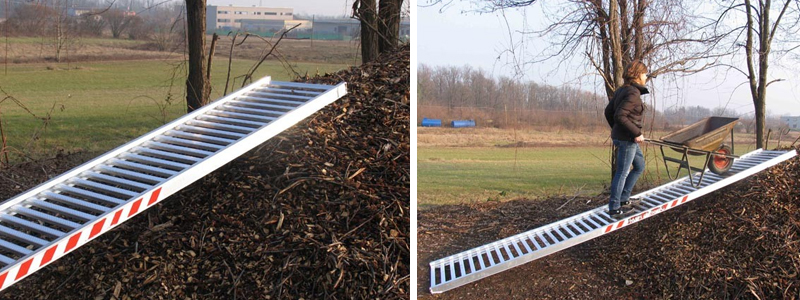
Loading a skip and waste regulations
Hiring a skip doesn’t come cheap and there is no commercial experience needed to load one. While loading a skip isn’t exactly rocket science there are a few best practices, such as the use of a skip ramp, to keep in mind.
Prep the skip area
Before your skip arrives make sure you clear an area big enough to accommodate it. Measure the area and ensure that the ground is flat and stable with enough room to provide easy access to and from the skip. Depending on the weather and the area you may need to make sure the ground isn’t too wet or marshy, as heavy skips may sink. Clear the area of any rubbish and obstructions to avoid any unfortunate accidents around the skip site.
Use a skip ramp
Using a skip ramp is a safer and easier way of loading a skip, particularly if you have waste that will need to be loaded by wheelbarrow such as soil or bricks. As a fully TUV certified ramp, our skip ramps can be safely used at a gradient of no more than 30%, or 1:3.3. To figure out the right skip ramp length for you simply multiply your load height, or your skip height, by 3.3. Fortunately, we offer a wide range of skip and loading ramps to suit a variety of different loads heights. With a durable robot welded aluminium construction and lightweight design these ramps are ideally suited to use temporarily for skip loading and can easily be transported and stored. A simple rest on connection means they are easy to set up and require no experience while offering a safe and secure way to load waste into your skip. If in any doubt about the right length skip ramp for your needs or if you are unsure about the safest way to load with your skip ramp, call one of our friendly sales team to explore our range and find the right fit for you. 
Beware of weight
If you’ve hired a large skip, make sure you’re careful about the weight. The skip lorry will only be able to able to take a certain capacity, so loading your skip with overly heavy items may cause it to become a dangerous load weight. This can be a costly mistake as your skip company can refuse to take the skip and charge you extra for an additional skip and lorry.
Look out for material restrictions
While there is plenty that you can safely put in your skip, there are some hazardous items that you should beware of. These are items that require special care when being disposed of. If you are unsure what is restricted check with your skip company and if you’re ever in doubt, leave it out. Here are some restricted items to look out for:
- Solvents
- Batterie
- Fridges and Freezers
- Toxic waste
- Toxic gases
- Medical waste
Don’t over fill your skip!
This is probably one of the most important regulations and the most overlooked despite being both dangerous and costly. When loading your skip make sure you don’t fill anything above the marked load line. To avoid any costly mistakes, make sure you have a clear idea of how much you need to load beforehand so you can hire the right size and avoid over paying for one that is too big or for an additional one if the first is too small. If you do over load your skip, be warned that your skip company has the right to refuse to take the skip until it is filled to a safe level. 
Break up bulk items
It may seem obvious but often laziness and lack of preparation mean bulky items end up being thrown into skips whole. This leaves gaps that take up space and can cost you money in the long run. Furniture items like wardrobes and drawers can often be dismantled and broken down to create more room, ensuring you don’t overload your skip or have to pay for wasted space.
Put heavier items in the bottom
The safest way to load your skip is to try and put heavier items in the bottom and fill with lighter items towards the top. This stops items moving around in a dangerous way and ensures the skip is as stable as possible when it comes time to load and transport.







